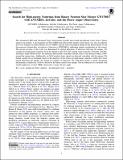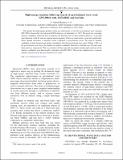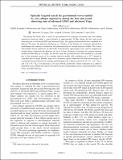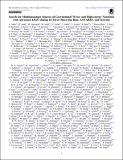Search for High-energy Neutrinos from Binary Neutron Star Merger GW170817 with ANTARES, IceCube, and the Pierre Auger Observatory
Author(s)
ANTARES Collaboration; IceCube Collaboration; Pierre Auger Collaboration; LIGO Scientific Collaboration; Virgo Collaboration; Arguelles Delgado, Carlos A; Axani, Spencer Nicholas; Collin, G. H.; Conrad, Janet Marie; Moulai, Marjon H.; Aggarwal, Nancy; Barsotti, Lisa; Biscans, Sebastien; Buikema, Aaron; Demos, Nicholas; Donovan, Frederick J; Eisenstein, Robert Alan; Essick, Reed Clasey; Evans, Matthew J; Fernandez Galiana, Alvaro-Miguel; Fritschel, Peter K; Gras, Slawomir; Hall, Evan D.; Katsavounidis, Erotokritos; Kontos, Antonios; Lanza Jr, Robert K; Lynch, Ryan Christopher; MacInnis, Myron E; Martynov, Denis; Mason, Kenneth R; Matichard, Fabrice; Mavalvala, Nergis; McCuller, Lee P; Miller, John; Mittleman, Richard K; Ray Pitambar Mohapatra, Satyanarayan; Shoemaker, David H; Tse, Maggie; Vitale, Salvatore; Weiss, Rainer; Yu, Hang; Yu, Haocun; Zucker, Michael E; ... Show more Show less
DownloadAlbert_2017_ApJL_850_L35.pdf (1.223Mb)
PUBLISHER_CC
Publisher with Creative Commons License
Creative Commons Attribution
Terms of use
Metadata
Show full item recordAbstract
The Advanced LIGO and Advanced Virgo observatories recently discovered gravitational waves from a binary neutron star inspiral. A short gamma-ray burst (GRB) that followed the merger of this binary was also recorded by the Fermi Gamma-ray Burst Monitor (Fermi-GBM), and the Anti-Coincidence Shield for the Spectrometer for the International Gamma-Ray Astrophysics Laboratory (INTEGRAL), indicating particle acceleration by the source. The precise location of the event was determined by optical detections of emission following the merger. We searched for high-energy neutrinos from the merger in the GeV-EeV energy range using the Antares, IceCube, and Pierre Auger Observatories. No neutrinos directionally coincident with the source were detected within ± 500 s around the merger time. Additionally, no MeV neutrino burst signal was detected coincident with the merger. We further carried out an extended search in the direction of the source for high-energy neutrinos within the 14 day period following the merger, but found no evidence of emission. We used these results to probe dissipation mechanisms in relativistic outflows driven by the binary neutron star merger. The non-detection is consistent with model predictions of short GRBs observed at a large off-axis angle.
Date issued
2017-11Department
Massachusetts Institute of Technology. Department of Physics; Massachusetts Institute of Technology. Laboratory for Nuclear Science; MIT Kavli Institute for Astrophysics and Space ResearchJournal
Astrophysical Journal
Publisher
American Astronomical Society
Citation
Albert, A. et al. “Search for High-Energy Neutrinos from Binary Neutron Star Merger GW170817 with ANTARES, IceCube, and the Pierre Auger Observatory.” The Astrophysical Journal 850, 2 (November 2017): L35 © 2017 The American Astronomical Society
Version: Final published version
ISSN
2041-8213
Collections
Related items
Showing items related by title, author, creator and subject.
-
High-energy neutrino follow-up search of gravitational wave event GW150914 with ANTARES and IceCube
Adrián-Martínez, S.; Albert, A.; André, M.; Anghinolfi, M.; Anton, G.; e.a. (American Physical Society, 2016-06)We present the high-energy-neutrino follow-up observations of the first gravitational wave transient GW150914 observed by the Advanced LIGO detectors on September 14, 2015. We search for coincident neutrino candidates ... -
Optically targeted search for gravitational waves emitted by core-collapse supernovae during the first and second observing runs of advanced LIGO and advanced Virgo
LIGO Scientific Collaboration; Virgo Collaboration; ASAS-SN Collaboration; DLT40 Collaboration; Aggarwal, Nancy; e.a. (American Physical Society (APS), 2020)© 2020 American Physical Society. We present the results from a search for gravitational-wave transients associated with core-collapse supernovae observed within a source distance of approximately 20 Mpc during the first ... -
Search for Multimessenger Sources of Gravitational Waves and High-energy Neutrinos with Advanced LIGO during Its First Observing Run, ANTARES, and IceCube
ANTARES Collaboration; IceCube Collaboration; LIGO Scientific Collaboration; Virgo Collaboration; Arguelles Delgado, Carlos A; e.a. (American Astronomical Society, 2019)© 2019. The American Astronomical Society.. Astrophysical sources of gravitational waves, such as binary neutron star and black hole mergers or core-collapse supernovae, can drive relativistic outflows, giving rise to ...


